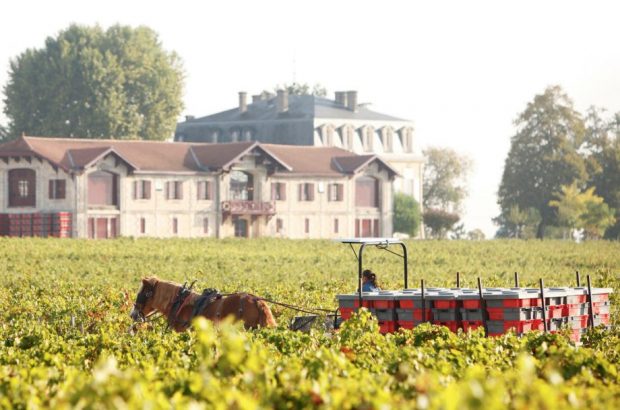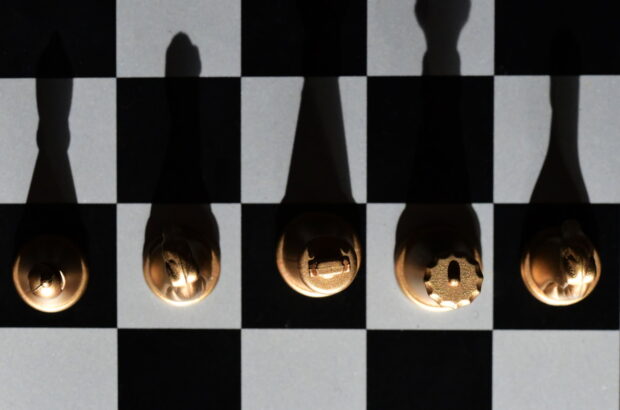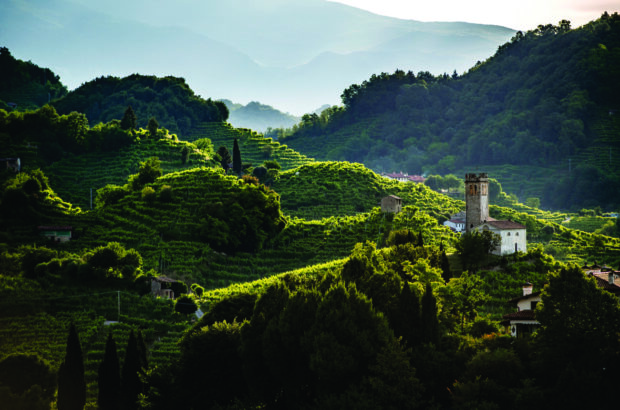11 different vintages ranging from 2015 (the most recent from most wineries) back to a sole, brave example from distant 1998!
Entry criteria Producers and UK agents were invited to submit their latest-release Riserva, single-vineyard or special-selection Amarone della Valpolicella wines
Four vintages accounted for nearly 75% of the wines: in descending order 2015 (25%), 2012 (22%), 2013 (14%) and 2011 (11%).
Significantly, the top eight wines featured six different vintages – a clear indication that vintage is not always quite such a key consideration with Amarone. While the winemaking process itself makes these sumptous and challenging wines tick, it should nonetheless be noted that no wines from the generally poor 2014 vintage managed to achieve our Highly Recommended rating.
Sub-zones and styles
{"content":"PHA+UmVnYXJkaW5nIGRlbm9taW5hdGlvbnMsIGVudHJpZXMgZnJvbSBBbWFyb25lIENsYXNzaWNvIGRvbWluYXRlZCAoNDkgd2luZXMpLCBtb3JlIHRoYW4gb25lLXRoaXJkIG9mIHdoaWNoIHdlcmUgUmlzZXJ2YXMuIFRoaXMgYXJlYSB0ZW5kcyB0byBwcm9kdWNlIHdpbmVzIG9mIGEgbW9yZSBleHBhbnNpdmUgYW5kIGVsZWdhbnQgY2hhcmFjdGVyLjwvcD4KPHA+PGRpdiBjbGFzcz0iYWQtY29udGFpbmVyIGFkLWNvbnRhaW5lci0tbW9iaWxlIj48ZGl2IGlkPSJwb3N0LWlubGluZS0yIiBjbGFzcz0iaXBjLWFkdmVydCI+PC9kaXY+PC9kaXY+PC9wPgo8cD5Gcm9tIHRoZSBicm9hZGVyIFZhbHBvbGljZWxsYSBkZW5vbWluYXRpb24gKHdoZXJlIHRoZSB3aW5lcyBhcmUgdHlwaWNhbGx5IGRlbnNlciBhbmQgbW9yZSBtdXNjdWxhciksIHRoZXJlIHdlcmUgMjEgZXhhbXBsZXMgYW5kIGp1c3QgdW5kZXIgYSBxdWFydGVyIG9mIHRoZXNlIHdlcmUgUmlzZXJ2YXMuPC9wPgo8cD5BIHNvbGUgZXhhbXBsZSBmcm9tIHRoZSBWYWxwYW50ZW5hIHN1Yi16b25lIChsaWdodGVyLCBmcnVpdGllciB3aW5lcykgY29tcGxldGVkIHRoZSBsaW5lLXVwLjwvcD4KPHA+VGhlIGhpZ2hlci1zY29yaW5nIHdpbmVzIHdlcmUgbWFpbmx5IGVpdGhlciBDbGFzc2ljbyBvciBDbGFzc2ljbyBSaXNlcnZhLCBidXQgdGhlcmUgd2FzIG5vIEFtYXJvbmUgUmlzZXJ2YSBmcm9tIHRoZSBicm9hZGVyIERPQ0cgYXJlYSBhbW9uZyB0aGUgSGlnaGx5IFJlY29tbWVuZGVkIHdpbmVzLjwvcD4KPGRpdiBjbGFzcz0iYWQtY29udGFpbmVyIGFkLWNvbnRhaW5lci0tbW9iaWxlIj48ZGl2IGlkPSJwb3N0LWlubGluZS0zIiBjbGFzcz0iaXBjLWFkdmVydCI+PC9kaXY+PC9kaXY+CjxwPlF1aXRlIGZvcnR1aXRvdXNseSwgdGhlIHRvcCB0aHJlZSBPdXRzdGFuZGluZyB3aW5lcyB3ZXJlIGVhY2ggYSBkaWZmZXJlbnQgZXhwcmVzc2lvbiBvZiB0aGUgcHJpbmNpcGFsIGludGVycHJldGF0aW9ucyBvZiA8YSBocmVmPSJodHRwczovL3d3dy5kZWNhbnRlci5jb20vbGVhcm4vYW1hcm9uZS13aW5lLWFzay1kZWNhbnRlci0zODI1NzUvIj5BbWFyb25lPC9hPiwgaW5jbHVkaW5nIGEg4oCYcmVndWxhcuKAmSB2ZXJzaW9uIChCcmlnYWxkYXJh4oCZcyBsb3ZlbHkgMjAxNSksIGEgcHJlbWl1bSDigJhtb2Rlcm5pc3TigJkgd2luZSAoRGFsIEZvcm5v4oCZcyBpbW1lbnNlIDIwMTIpIGFuZCBhIG1hdHVyZSBSaXNlcnZhICh0aGUgZ2xvcmlvdXMgQ29ydGUgU2FuIEJlbmVkZXR0bywgQ2FtcG9yYWwgMjAwOSkuIE9uY2UgYWdhaW4gPGEgaHJlZj0iaHR0cHM6Ly93d3cuZGVjYW50ZXIuY29tL2xlYXJuL2FtYXJvbmUtd2luZS1hc2stZGVjYW50ZXItMzgyNTc1LyI+QW1hcm9uZTwvYT4g4oCYZGVsaXZlcmVk4oCZLCBpcnJlc3BlY3RpdmUgb2YgYW55IGNvbnNpZGVyYXRpb25zIG9mIHN1Yi1nZW5yZTogbm8gc2luZ2xlIHN0eWxlIG9yIGRlbm9taW5hdGlvbiB0cnVseSBzdG9vZCBvdXQuPC9wPgo8cD5FeHBlY3RhdGlvbnMgd2VyZSBtaXhlZDogd2hpbGUgQW5kcmV3IEplZmZvcmQgZmVsdCB0aGF0IEFtYXJvbmUgaXMgYSB3b25kZXJmdWxseSBleGNpdGluZyB3aW5lIHRvIHRhc3RlLCBNb250eSBXYWxkaW4gd2FzIG1vcmUgY2F1dGlvdXMsIHdhcnkgb2YgaHVnZSB3aW5lcyB3aXRoIHRvbyBtdWNoIG9hayBhbmQgcmVzaWR1YWwgc3VnYXIuIEhvd2V2ZXIgaGUgd2FzIHdvbiBvdmVyIGJ5IHRoZSBjb21iaW5hdGlvbiBvZiBiaWcsIGJvbGQgZnJ1aXQgY2hhcmFjdGVycywgcGVyc3Vhc2l2ZSB0ZXh0dXJlIGFuZCBkcnksIHNhdm91cnkgZmluaXNoIHRoYXQgbWFya2VkIG91dCB0aGUgYmVzdCBleGFtcGxlcy4gSmVmZm9yZCBhZ3JlZWQgdGhhdCBiYWxhbmNlIHdhcyBrZXk6IG9haywgc3VnYXIsIGdlbmVyb3VzIGFsY29ob2wgbGV2ZWxzIGFuZCB0YW5uaW5zIHdvcmsgd2VsbCBpbiB0YW5kZW0gd2hlbiBubyBvbmUgZWxlbWVudCBvdmVyc2hhZG93cyB0aGUgb3RoZXJzLjwvcD4KPGRpdiBjbGFzcz0iYWQtY29udGFpbmVyIGFkLWNvbnRhaW5lci0tbW9iaWxlIj48ZGl2IGlkPSJwb3N0LWlubGluZS00IiBjbGFzcz0iaXBjLWFkdmVydCI+PC9kaXY+PC9kaXY+CjxoMz5BZ2VhYmlsaXR5PC9oMz4KPHA+UGVyaGFwcyB0aGUgbW9zdCBub3Rld29ydGh5IG91dGNvbWUgd2FzIHRoZSBmYWN0IHRoYXQgeW91bmcsIG1lZGl1bS1tYXR1cmUgYW5kIGZ1bGx5IGRldmVsb3BlZCB3aW5lcyBhbGwgZm91bmQgZmF2b3VyLiBUaGUgYWdlaW5nIHBvdGVudGlhbCBvZiBBbWFyb25lIGlzIHZlcnkgbXVjaCBhIG1vb3QgcG9pbnQ6IHdoaWxlIHRoZXJlIGlzIG5vIGRlbnlpbmcgdGhhdCB0aGUgYmVzdCB3aW5lcyBhcmUgaW5kZWVkIGNhcGFibGUgb2YgdGFraW5nIGEgY291cGxlIG9mIGRlY2FkZXMgaW4gdGhlaXIgc3RyaWRlLCB0aGV5IGFyZSBub25ldGhlbGVzcyBlbmpveWFibGUgYW5kIGFwcHJvYWNoYWJsZSBhdCBwcmV0dHkgbXVjaCBldmVyeSBzdGFnZSBpbiB0aGVpciBkZXZlbG9wbWVudCwgYXMgdGhlIHJlc3VsdHMgb2YgdGhpcyB0YXN0aW5nIGRlbW9uc3RyYXRlIHZlcnkgY2xlYXJseS48L3A+CjxwPldoZXRoZXIgdGhlc2Ugd2luZXMgYXJlIGJlc3QgZHJ1bmsgeW91bmcgb3IgY2VsbGFyZWQgaXMgdGhlIG1pbGxpb24tZG9sbGFyIHF1ZXN0aW9uLiBKZWZmb3Jk4oCZcyB2aWV3IHN1bW1lZCB1cCB0aGUgZ2VuZXJhbCBmZWVsaW5nOiDigJhJ4oCZZCBkcmluayB0aGVtIG5vdywgYnV0IHRoZSBiZXN0IGRvIGluZGVlZCBhZ2UgdmVyeSB3ZWxsLiBEbyB0aGV5IGdldCBiZXR0ZXIgdGhvdWdoPyBJ4oCZbSBub3Qgc3VyZS7igJk8L3A+CjxkaXYgY2xhc3M9ImFkLWNvbnRhaW5lciBhZC1jb250YWluZXItLW1vYmlsZSI+PGRpdiBpZD0icG9zdC1pbmxpbmUtNSIgY2xhc3M9ImlwYy1hZHZlcnQiPjwvZGl2PjwvZGl2Pgo8cD5NeSBvd24gdmlldyBpcyB0aGF0IGVhY2ggd2luZSBoYXMgaXRzIG93biBwYXRoOiB3aGVyZWFzIERhbCBGb3JubyYjODIxNztzIEFtYXJvbmUgaXMgY2xlYXJseSB5ZWFycyBmcm9tIGJlaW5nIHJlYWR5LCBCcmlnYWxkYXJhJiM4MjE3O3Mgd2luZSBpcyBkcmlua2luZyBiZWF1dGlmdWxseSBhbHJlYWR5LCBzbyB3aHkgd2FpdD8gT25lIGlzc3VlIGhvd2V2ZXIgaXMgYmV5b25kIGRlYmF0ZTogdGhlIHBhbmVsIGFncmVlZCB1bmVxdWl2b2NhbGx5IHRoYXQgQW1hcm9uZSBvZmZlcnMgdmVyeSBnb29kIHZhbHVlIGZvciBtb25leS48L3A+CjxoMz48c3Ryb25nPlRoZSBKdWRnZXM8L3N0cm9uZz48L2gzPgo8cD48YSBocmVmPSJodHRwczovL3d3dy5kZWNhbnRlci5jb20vYXV0aG9yL21nYXJuZXIvIj5NaWNoYWVsIEdhcm5lcjwvYT4swqA8YSBocmVmPSJodHRwczovL3d3dy5kZWNhbnRlci5jb20vYXV0aG9yL2FuZHJld2plZmZvcmQvIj5BbmRyZXcgSmVmZm9yZDwvYT4swqA8YSBocmVmPSJodHRwczovL3d3dy5kZWNhbnRlci5jb20vYXV0aG9yL01vbnR5X1dhbGRpbi8iPk1vbnR5IFdhbGRpbjwvYT48L3A+CjxwPgo="}
Top Amarone from the panel tasting:
{}
{"wineId":"28631","displayCase":"standard","paywall":true}
{"wineId":"28632","displayCase":"standard","paywall":true}
{"wineId":"28633","displayCase":"standard","paywall":true}
{"wineId":"28634","displayCase":"standard","paywall":true}
{"wineId":"28635","displayCase":"standard","paywall":true}
{"wineId":"28636","displayCase":"standard","paywall":true}
{"wineId":"28637","displayCase":"standard","paywall":true}
{"wineId":"28638","displayCase":"standard","paywall":true}
{"wineId":"28639","displayCase":"standard","paywall":true}
{"wineId":"25396","displayCase":"standard","paywall":true}
{"wineId":"28641","displayCase":"standard","paywall":true}
{"wineId":"28642","displayCase":"standard","paywall":true}
{"wineId":"28643","displayCase":"standard","paywall":true}
{"wineId":"28644","displayCase":"standard","paywall":true}
{"wineId":"28645","displayCase":"standard","paywall":true}
{"wineId":"28646","displayCase":"standard","paywall":true}
{"wineId":"28647","displayCase":"standard","paywall":true}
{"wineId":"28648","displayCase":"standard","paywall":true}
{"wineId":"28649","displayCase":"standard","paywall":true}
{"wineId":"28650","displayCase":"standard","paywall":true}
{"wineId":"28651","displayCase":"standard","paywall":true}
{"wineId":"28652","displayCase":"standard","paywall":true}
{}
About Amarone
Amarone is produced throughout the Valpolicella denomination (including the sub-zones of Classico and Valpantena) from grapes dried until at least 1 December following the vintage and fermented out to a minimum of 14% alcohol. The wine may contain a maximum of between 12g/L and about 16g/L of sugar (depending on its total alcohol content), though 5-7g/L is more common. The wine is aged for a minimum of two years from the year following the vintage or for four years (beginning in November) for Riserva.
During its formative years in the second half of the 20th century, Amarone established a reputation as a ‘niche’ wine. Its unique production process of appassimento (drying the grapes) resulted in an instantly recognisable style: a rich, round red with aromas and flavours of semi-dried fruit, a high alcohol content and, frequently, generous levels of residual sugar.
However the introduction of ‘controlled appassimento’ towards the end of the 1990s opened up a whole new world: the use of giant fans and dehumidifers eliminated the risk of grey rot which had previously ruined many a crop of drying fruit. With supply lines of healthy raw materials finally secured, Amarone was no longer a rarity and production figures spiralled upwards at an alarming rate.
Three key styles
Over the first decade of the new millennium, the number of bottles produced annually tripled and now averages above 18 million. Amarone’s traditional role as vino da meditazione (a post-prandial to be sipped while discussing the finer things in life) was called into question. High alcohol and sugar levels make the wine a tricky match with food and, given the massive upsurge in production, Amarone had to find a place at table to keep pace with the consumer’s changing lifestyle.
Many producers went back to the drawing board: the rediscovery of long-forgotten grape varieties; more ‘complete’ fermentations heading towards a drier style; experiments with different-sized barrels and wood types, etc – all aimed at reshaping the wine’s identity.
Others dug their heels in and remained faithful to the time-honoured ways. Indeed, some continued to accept the presence of a small proportion of the fungus in its ‘larval’ or nascent form, ie: before full sporulation. As such, Muffa nobile or noble rot can confer expansive and developed aromas of macerated fruits plus the honeyed notes typical of botrytised wines and, in addition, boosts glycerol levels, enhancing the wine’s velvety texture.
The upshot of this activity accounts for the surprisingly wide spectrum of aromas and flavours typical of today’s Amarone. Three styles dominate current production. A simpler version usually with less wood ageing showcases its friendlier side: many believe that Amarone is best drunk by its 10th birthday when the wine is still all about roundness, softness and harmony.
Smaller batches of a grower’s very finest fruit are fermented separately and often given extra wood ageing; this ‘premium’ or Riserva version is capable of lasting for up to 20 years or so in bottle. Finally, the more ‘modernist’ interpretation of Amarone embraces a more concentrated, longer-lived and less oxidative style of wine through the use of controlled appassimento and mainly smaller (225L or 500L) new oak barrels.
Know your vintages
2015 A long, hot and dry summer gave big, ripe and rich wines with good phenolic maturity. Potentially excellent wines which mainly need keeping.
2014 A notoriously wet and cool year: while many wines are perfectly drinkable, they are not great either. To be drunk young.
2013 A cooler than average summer was followed by a warm and sunny autumn. The wines are particularly aromatic and the best show real finesse. Drink from 2020.
2012 Weather conditions turned patchy after an intensely hot summer. These big, generous wines are beginning to drink well.
2011 A highly touted vintage producing balanced wines which are approaching their peak. Drink or keep for three to five years.
2010 A cooler than average vintage: while perhaps lacking flesh, the wines have good aromas and are mainly fully mature.
You may also like:












